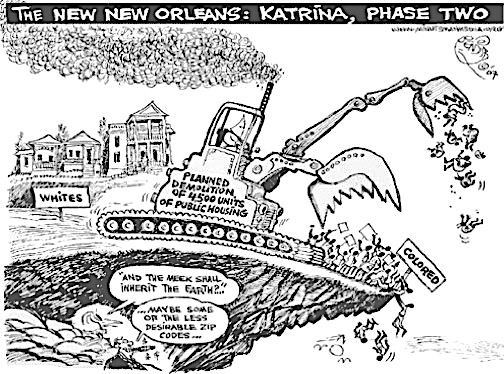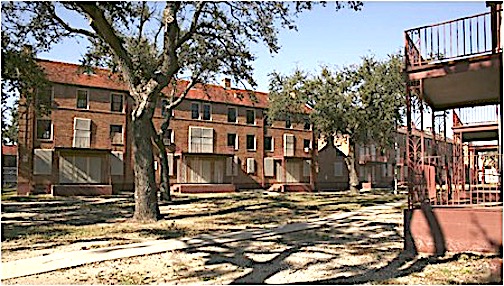Skip to content

When I first wrote “All They Will Call You Will Be ‘Refugees,’” for the San Francisco Bay View, right after the catastrophe of Katrina on September 2, 2005, I stated that “What is needed is a massive public works project, to rebuild this city—the birthplace of Jazz—to employ the people who have been disposed by Katrina and to rebuild this city from the ashes of the old!” I quoted Glen Ford of the Black Commentator radio station’s audio commentary on September 2, 2005, “Will the ‘New’ New Orleans be Black?” he expressed the problems and the process quite well:
One of the premiere Black cities in the nation faces catastrophe. There is no doubt in my mind that New Orleans will one day rise again from its below sea level foundations. The question is, will the new New Orleans remain the two-thirds Black city it was before the levees crumbled? Some would say it is unseemly to speak of politics and race in the presence of a massive calamity that has destroyed the lives and prospects of so many people from all backgrounds. But I beg to differ. As we have witnessed, over and over again, the rich and powerful are very quick to reward themselves as soon as disaster presents the opportunity. Remember that within days of 9/11, the Bush regime executed a multibillion dollar bailout for the airline industry. By the time you hear this commentary, they may have already used the New Orleans disaster to bail out the insurance industry—one of the richest businesses on the planet. But what of the people of New Orleans, 67 percent of whom are Black? New Orleans is a poor city. Twenty-eight percent of the population lives below the poverty line. Well over half are renters, and the median value of homes occupied by owners is only $87,000. From the early days of the flood, it was clear that much of the city’s housing stock would be irredeemably damaged. The insurance industry may get a windfall of federal relief, but the minority of New Orleans home owners will get very little—even if they are insured. The renting majority may get nothing. If the catastrophe in New Orleans reaches the apocalyptic dimensions towards which it appears to be headed, there will be massive displacement of the Black and poor. Poor people cannot afford to hang around on the fringes of a city until the powers-that-be come up with a plan to accommodate them back to the jurisdiction. And we all know that the prevailing model for urban development is to get rid of poor people. The disaster provides an opportunity to deploy this model in New Orleans on a citywide scale, under the guise of rebuilding the city and its infrastructure. In place of the jobs that have been washed away, there could be alternative employment through a huge, federally funded rebuilding effort. But this is George Bush’s federal government. Does anyone believe that the Bush men would mandate that priority employment go to the pre-flood, mostly Black population of the city. And the Black mayor of New Orleans is a Democrat in name only, a rich businessman, no friend of the poor. What we may see in the coming months is a massive displacement of Black New Orleans, to the four corners of the nation. The question that we must pose, repeatedly and in the strongest terms, is: Through whose vision, and in whose interest, will New Orleans rise again?. For Radio BC, I’m Glen Ford.”
Since that time, I have viewed the Spike Lee 2006 DVD, “When the Levees Broke: A Requiem in Four Acts,” Greg Palast’s 2006 DVD Video, “Big Easy to Big Empty—The Untold Story of the Drowning of New Orleans,” and Bill Quigley’s essay “The Cleansing of New Orleans.” I have come to the conclusion that the ethnic cleansing was a plan that was already in place, just waiting for a hurricane for its implementation. Or as Congressman Richard Baker, R-La., was overheard telling lobbyists, right after Katrina, “We finally cleaned up public housing in New Orleans. We couldn’t do it, but God did.” From his point of view, Katrina made it possible for the politicians to gentrify New Orleans and carry out the ethnic cleansing of the city.
They knew from past floods in 1927 and Hurricane Betsy in 1956, that when the levees break, working class and Black Communities get flooded. They knew that the levees were not constructed properly, yet the government of this country has refused to rectify this problem for 40 years! Palast investigates the politically connected company that was paid $500,000 by the U.S. government to develop a hurricane evacuation plan—“Innovated Emergency Management Inc. (IEM).” IEM never came up with a plan. It had nobody with the background to develop a plan.
Both Spike Lee and Greg Palast interview Dr. Ivor Van Heerden, Deputy Director of Louisiana State University’s Hurricane Center. Van Heerden reveals who knew what and when—before, during, and after the storm—and that his job was threatened for giving the information.
The Louisiana State University’s Hurricane Center had developed a hurricane evacuation plan that was totally ignored by the Local, State, and Federal Governments.
Van Heerden personally tired to make the government aware of the dangers, if a Hurricane hit New Orleans. Since Hurricane Betsy the levees were never rebuilt to withstand a flood brought on by a storm—not even a Type 1 Hurricane, which Katrina became as it hit the Gulf Coast east of New Orleans. He goes on to explain that someone in the government ordered the Army Corps of Engineers to build the levees one and a half feet lower than their original plans, which were inadequate. From the experience of the past major floods they knew that the lower 9th ward and part of Lake Pontchartrain was going to become flooded.
Van Heerden points out that 129,000 people without transportation were going to be left to the whims of the flood waters, if the government did not use its resources to evacuate them from harms way. His warnings fell on ears that would not listen and eyes that would not see.
He tells Palast that “FEMA knew at eleven o’clock on Monday August 29 that the levees had breached, at 2 o’clock they flew over the 17th St. Canal and took videos of the breaches, by midnight on Monday the White House knew, but none of us knew.”
“FEMA knew at eleven o’clock on Monday that the levees had breached, at 2 o’clock they flew over the 17th St. Canal and took video of the breaches, by midnight on Monday the White House knew, but none of us knew.”
The Louisiana State University’s Hurricane Center was never informed of the levee breaks until noon on Tuesday. Refusing to inform the citizens of the 9th ward about the impending danger and the local governments, if they were so inclined, from helping them get to higher ground. The 12-hour silence of the White House was deafening and an example of the conscious decision to begin the process of the Ethnic Cleansing of New Orleans—to remove the working class and Black poor from New Orleans.
A good example, of this intent of ethnic cleansing, is the boarding up the Lafitte public housing units, even though they were not flooded. Palast interviewed Patricia Thomas, who is now homeless and is locked out of her public housing unit in the Lafitte housing project near the French Quarter. Palast went with her as she entered her blockaded apartment and found that it was not damaged by the flooding and could be reopened within a week’s time. As she said about the closing of Lafitte, “Katrina didn’t do this. Man did this. This was man made.”
Palast explained in his Video that these units are two and three story townhouses, unlike public housing found in other cities in the United States. But Palast points out that the Lafitte housing project is between downtown New Orleans and the French Quarter—prime real estate, to be replaced by housing affordable to the rich.
Glen Ford, explained this process very well in his Black Agenda Reportessay, “Tear Down the Ghetto: The Price is Wrong.” He wrote:
“If these ghetto houses cannot be financed at the bubble prices demanded, then they must be torn down…. It is now proposed that the ‘excess’ housing stock of the United States be knocked down, bulldozed until a renewed shortage of shelter will render the housing that survives worth something close to the prices advertised before the bubble burst.” ( Black Agenda Report.)
In his Big Easy video, Palast talked to Brod Bagert, former New Orleans’ City Councilman and lawyer, who took Palast to mile after mile of devastated homes near the levees that were supposed to protect the city from flooding and to protect the people who died. He describes this devastation as “criminal ‘reckless negligence.’”
Palast also interviews Pamela Lewis, who had guns shoved in her face when she tried to evacuate with her 86-year-old mother, relocated over 100 miles from the city to one of FEMA’s trailers, that off-gassed formaldehyde, in “parks” fenced in with barbed-wire. The trailer “park” is in a field literally in the middle of nowhere behind an Exxon Oil Refinery—the only bus available for residents goes only to Wal-Mart. In the video, Ms. Lewis states, “It is a prison setup. I’ve never been to the bottom of the barrel until I came here.”
During the course of the video we learn that more than half the original residents cannot return to “The City That Care Forgot.” They now know how it feels to leave New Orleans.
In his essay, “Half the City’s Poor Now Permanently Displaced: The Cleansing of New Orleans,” Bill Quigley wrote: “Government reports confirm that half of the working poor, elderly and disabled who lived in New Orleans before Katrina have not returned. Because of critical shortages in low cost housing, few now expect tens of thousands of poor and working people to ever be able to return home.” ( Black Commentator).
What Glen Ford said in his September 2005 assessment of the situation facing the poor of New Orleans has proven true: “If the catastrophe in New Orleans reaches the apocalyptic dimensions towards which it appears to be headed, there will be massive displacement of the Black and poor. Poor people cannot afford to hang around on the fringes of a city until the powers-that-be come up with a plan to accommodate them back to the jurisdiction. And we all know that the prevailing model for urban development is to get rid of poor people. The disaster provides an opportunity to deploy this model in New Orleans on a citywide scale, under the guise of rebuilding the city and its infrastructure.”
The Ethnic Cleansing of the port city of New Orleans is now under way and to make New Orleans the casino capital and the playland of the South.
But New Orleans has lost its soul—it is now majority white. It was the birthplace of jazz. Jazz, to me, represents the aspirations of an oppressed people for democracy. Those aspirations have been shattered. (The powers that be are also now trying to gentrify jazz.)
For producing the video “Big Easy to Big Empty—The Untold Story of the Drowning of New Orleans,” exposing what went wrong when Kartina struck, in an act of attempted intimidation, the Federal Government, through the Department of Homeland Security, filed a complaint against Greg Palast. The bogus charge of filming “criminal infrastructure” was later dropped. But guess whom the Federal Government did hire to determine what went wrong? You guessed it—Innovated Emergency Management Inc. (IEM)—the company that failed to come up with an evacuation plan prior to Katrina!

